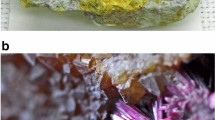Abstract
Ingested arsenic is known to be not only excreted by urine, but to be stored in sulphydryl-rich tissue like hair, nail or skin. We developed an extraction method for arsenic species from these tissues and studied the stability of different arsenic species during the extraction process. Inorganic and pentavalent methylated arsenic was found to be stable under the extraction conditions, whereas trivalent methylated arsenicals and the thio-analogue of DMAV (DMAS) showed reduced stability. The absorption ability of hair for these different species was studied as well. Inorganic arsenic is better absorbed by hair than monomethyl- or dimethyl-arsenicals, whereby the trivalent forms are taken up better than the pentavalent forms. Independent of which methylated arsenical was used for the incubation, the pentavalent form was always the dominant form after extraction. Hair and nail samples from humans suffering from chronic arsenic intoxication contained dominantly inorganic arsenic with small and strongly varying amounts of DMAV and MAV present. DMAS was only found in some nail sample extracts containing unusually high amounts of DMAV and is believed to be formed during the extraction process.



Similar content being viewed by others
References
Vahter M (2000) Toxicol Lett 112–113:209–217
Challenger F (1945) Chem Rev 36:315–361
Thomas DJ, Styblo M, Lin S (2001) Toxicol Appl Pharm 176:127–144
Hindmarsh JT (2002) Clin Biochem 35:1–11
Vahter M (1994) Clin Chem 40:679–680
Le XC, Lu XF, Ma MS, Cullen WR, Aposhian HV, Zheng BS (2000) Anal Chem 72:5172–5177
Young EG, Smith RP (1942) Brit Med J 251–253
Lima FW (1966) In: Proc 11th Int Conf Forensic Act Analysis, San Diego, CA, pp 261–277
Morton J, Carolan VA, Gardiner PHE (2002) Anal Chim Acta 455:23–34
Klevay LM, Bistrian BR, Fleming CR, Neumann CG (1987) Am J Clin Nutr 46:233–236
Hambidge KM (1982) Am J Clin Nutr 36:943–949
Hardy MH (1992) Trends Genet 8:55–61
Cullen WR, McBride BC, Manji H, Pickett AW, Reglinsky J (1989) Appl Organomet Chem 3:71–78
Burrows GJ, Turner EEJ (1920) Chem Soc Trans 117:1373–1383
Reay PF, Asher CJ (1977) Anal Biochem 78:557–560
Hansen HR, Raab A, Jaspars M, Milne BF, Feldmann J (2004) Chem Res Toxicol 17:1086–1091
Raab A, Hansen HR, Zhuang L, Feldmann J (2002) Talanta 58:67–76
Feldmann J, Lai VW-M, Cullen WR, Ma M, Lu X, Le XC (1999) Clin Chem 45:1988–1997
Hansen HR, Pickford R, Thomas-Oates J, Jaspars M, Feldmann J (2004) Angew Chem Int Edit 43:337–340
Pott WA, Benjamin SA, Yang RSH (2001) Rev Environ Contam T 169:165–214
Vahter M, Norin H (1980) Environ Res 21:446–457
Young EG, Rice FA (1944) J Lab Clin Med 29:439–446
Acknowledgements
We thank Dr. Chandra N. Sekaran and Dr. K.S. Patel for the hair and nail samples from West Bengal and Central India (Rajnandgaon), and A.R. thanks the College of Physical Sciences of the University of Aberdeen for financial support.
Author information
Authors and Affiliations
Corresponding author
Rights and permissions
About this article
Cite this article
Raab, A., Feldmann, J. Arsenic speciation in hair extracts. Anal Bioanal Chem 381, 332–338 (2005). https://doi.org/10.1007/s00216-004-2796-6
Received:
Revised:
Accepted:
Published:
Issue Date:
DOI: https://doi.org/10.1007/s00216-004-2796-6




